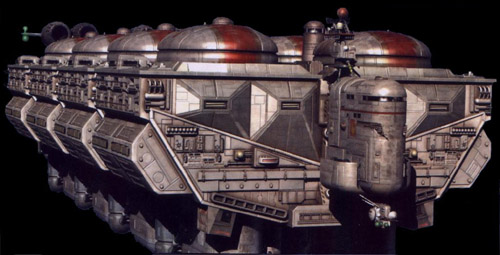
UGC Clariont Flag. | Tanker Ships. | 
UGC Clariont Flag. |
|---|
 | | The Tanker Ship SOUTHERN VIEW, Belonging To 14ᵀᴴ Fleet. |
|---|
Tanker Ships deliver liquid and gaseous loads (other than fuels) around. The load may be highly volatile, such as Detonex (used in anti-matter bombs), hydrogen, etc, or may be hyper-stable, such as water. Tanker ships, due to the potentially volatile nature of their loads, rarely, if ever, process the raw materials; The lack of processing equipment also allows them to carry more load, though the argument that installing such equipment increases efficiency, as the ship can load up on raw material, then process it enr has gained support in certain (profit-motivated) circles.Tanker ships do, however, have a very serious black mark; They are known, with unstable cargos at least, to spontaneously EXPLODE. The cause is generally known (cargo leakage), however specifics are not available in every case, as the destruction is very literally complete. Also, non-volatile cargos have, on occasion, exploded; Investigators usually chalk it up to cargo leaking from a vat (as the actual containers themselves are called) in some catastrophic fashion, hyper-pressurizing the vsl.Note that there is no one class of Tanker ships; Almost every single ship is different, and there are no more than 2,000 identical ones (usually there are not more than 3 of a "class").It has been noted that Tanker Ships do not carry "fuel" around; Some actually do, but can NOT refuel other ships. This is the domain of the Refueler, which may or may not be capable of taking fuel directly off of a Tanker.Type: Cargo ShipClass: Fuels.Crew: Varies by ship; As little as 1,000 to 10 times that number.MDC By Location: |
Main Hull:
Bridge: | Varies by ship; Generally about 10 per every 100 crewmen.Varies by ship; Generally 1 per every 100 Hull MDC. | Hatches: | Large through-hull hatches have 500 MDC, smaller internal hatches, doors, and scuttles generally only about 100. The exact number of hatches, doors, and scuttles vary, but two large through-hull hatches and 10-100 smaller, humanoid-sized through-hull hatches (underside only) are common. |
| Speed and Statistical Data: |
Space Fold: Not Usually Equipped.
FTL: Factor 5
Cruising Speed: Mach 20.
Clearance: Varies; Generally 100 to 500 feet.
Beam: Generally equal to the clearance.
Length: Varies; Generally 100 times the beam.
Weight: Varies. Generally about 1 ton per every 10 crewmen.
Cargo: Varies; Generally about 1,000 tons of cargo per every ton of vsl.
Cruise Duration: Varies, but generally VERY short, 6 months is considered a "long cruise" for a tanker ship.
Power Plant:Primary: Various nuclear reactors; Output varies greatly.Secondary: Solar panel arrays; Often used in place of the main power plant, since it's free, if circumstances permit. When otherwise, it is generally used only in emergencies.Tertiary: Battery back up. These are only used in GRAVE emergencies, but have a full six-week capability at basic life-support levels. | SPECIAL FOR HYDROGEN-HAULING VSL: Hydrogen-hauling vsls often use hydrocell generators as another backup generator system. These are perfectly safe, and the most expedient systems, when practicable.
Propulsion:Primary: Tractioning drives;Secondary: Rocket power. Hydrogen-hauling vsls also use hydrocell thrusters when practicable.
Flight System: Not Applicable; Not planet-fall capable.
Cost and Availability: Every crewman equals about 200credits towards construction cost; Takes about 6 months to build.
Black Market Cost and Availability: Varies VERY greatly; Only ships stolen from somewhere else would be available on the black market, and since these are pretty big ships, it's hard to off-load one. However, malconts often swap these and other vsls between each other for various purposes.
|
| Weapons Systems:Because these ARE civilian vsls, they are rarely armed with anything but the most basic self-defense mechanisms. |
1. Full-Force Barrier Field: This type of vsl generally has a full-force barrier field, but only a fairly light and rudimentary one.
MDC: Generally not more than about 150 to 500
Range: Self + about 10 feet.
Payload: Technically unlimited; However, the barrier field prevents ANY approach to the vsl, and therefore must be lowered to allow cargo shuttles, in.
Attacks Per Melee: Technically unlimited; Requires one melee action to raise, if the operator happens to be standing right there when the attack begins. Sadly, all too often they are not. | 2. Point Defense Lasers: These automated laser batteries kick in whenever the Collision alarm alerts. Rarely are there more than four, though.
MD: 1D4 times 10 per blast.
Range: 100 feet.
Payload: Unlimited.
Attacks Per Melee: Twice per melee.
|
| Features: |
- ESM: Radar Detector. Passively detects other radars being operated.
- Radar: Combat grade radar. Range 100 miles, can track up to 50 individual targets. 95% reliability (24% against unfriendly stealthed vehicles).
- Blue Force Tracker: Identifies friend from foe. Overlays the information on both the radar and HUD, ensuring that friendly forces are not accidentally targeted.
- GPS: Standard tracking device. Ties into the Blue Force Tracker.
- Anti-Jamming System: Reduces Electronics Countermeasure by 25% (decrease skill level appropriately).
- HUD: Displays maps, radar, targeting information, and any OTHER information the wearer wants directly in front of the user. One is located at each weapons control station, and another makes up the majority of the bridge.
- FLIR/SLIR: Forward and Side Looking Infrared. Allows pilot to get visuals on targets at night.
- 1 MC: Internal loudspeaker.
| - Virtual Map: Displays a continuously-updating map of local terrain for the bridge. Takes data from and gives data to other friendly units in the area. Effective navigation of 85% as updates come. Good to 500 miles. Specific range can be adjusted in 10,000 mile increments.
- Video Camera: Records from the HUD. 5,000 hours of recording available.
- Full range optic sensory suite: Infrared, ultra violet, Magnification, night sight, color filters, thermal imager. Range: 200 miles for MOST sensors.
- Survival Pack: A pack of simpler emergency survival supplies: Pup tent, sleeping bag, black light, GPS, first aid kit (bandages, gauze, bandage tape, pads, antiseptic/analgesic), plasma torch (for small repairs and starting fires), repair kit (with MDC Repair Spray), sewing kit (a small spool of thread and 5 needles),
7 star flares (250 feet apogee), 2 white parachute flares (1,500 feet apogee), 100 feet of black or brown parachute cord (150 lbs tensile strength), 2-5 days rations, 2 gallons water, water purification kit- good for about 10 gallons.
|
Average Combat Profile For A Standard Tanker Ship:- 2 movement actions (dodges) per melee.
- 3 defensive actions (parries, typically with Point Defense Shields) per melee.
- 4 aggressive actions (attacks) per melee.
- +6 Strike with laser batteries.
- +8 Parry with shield.
|


